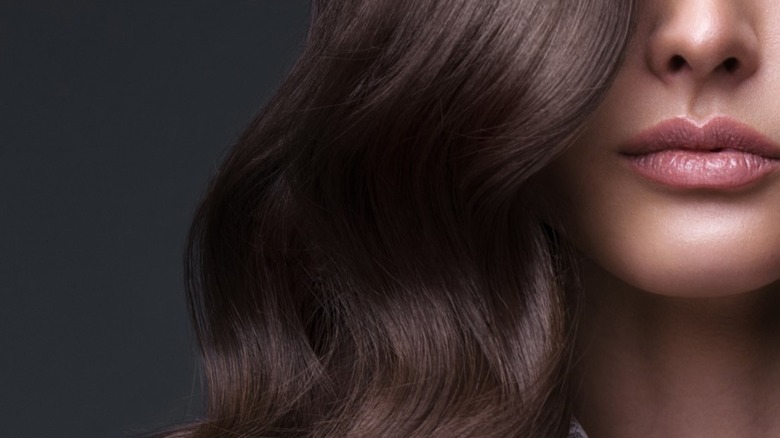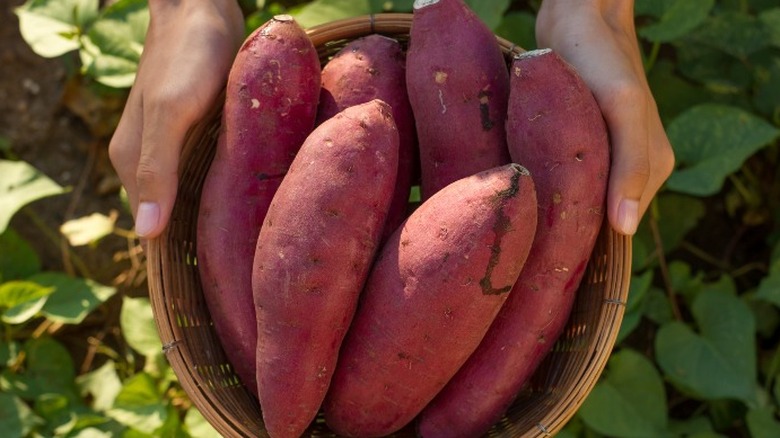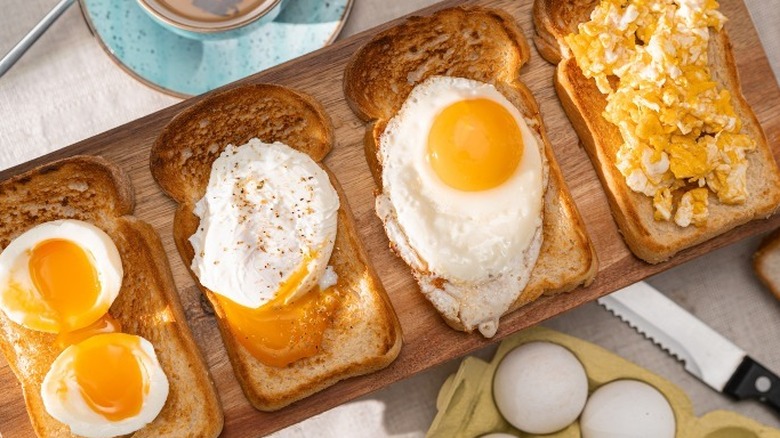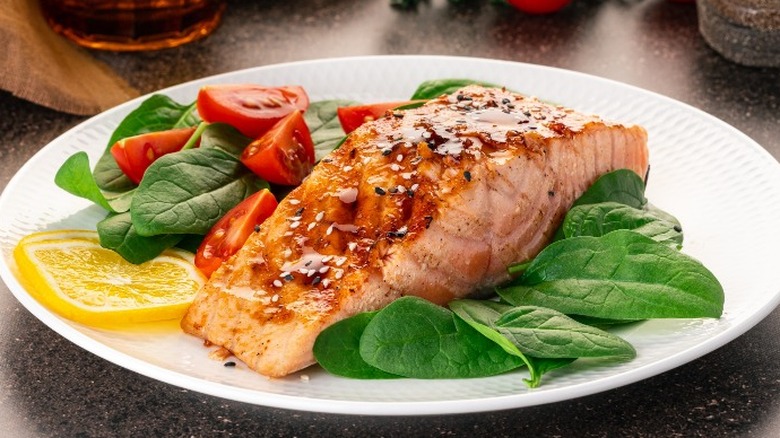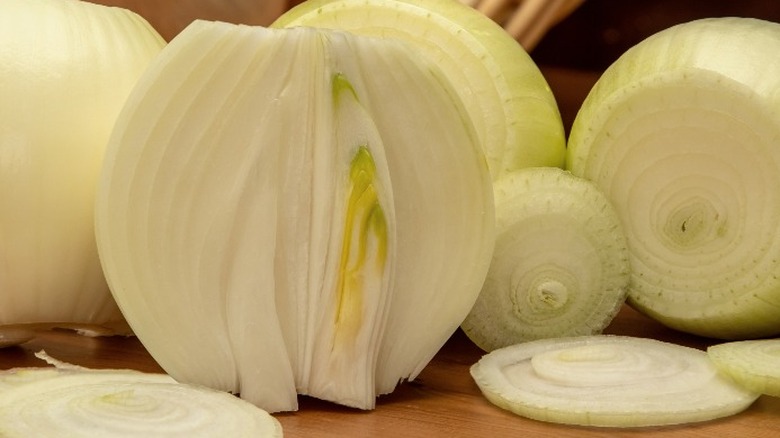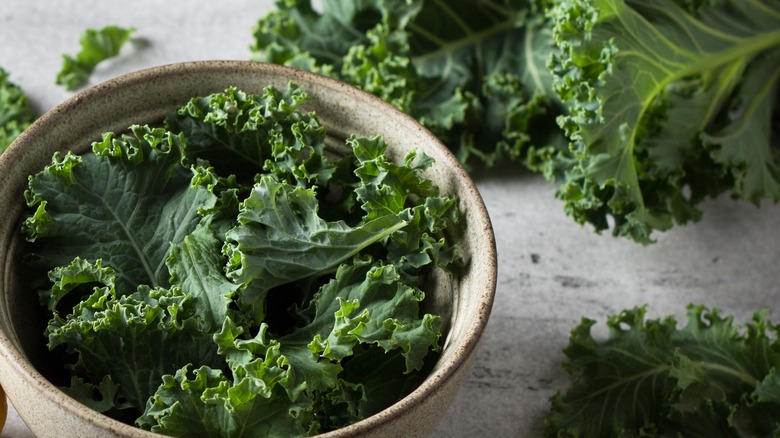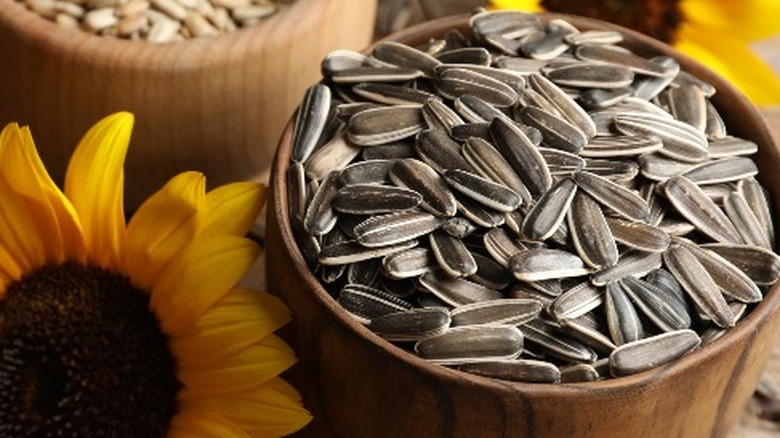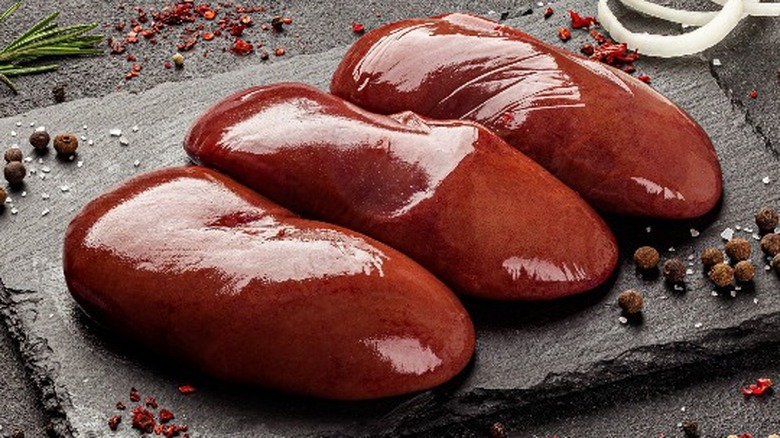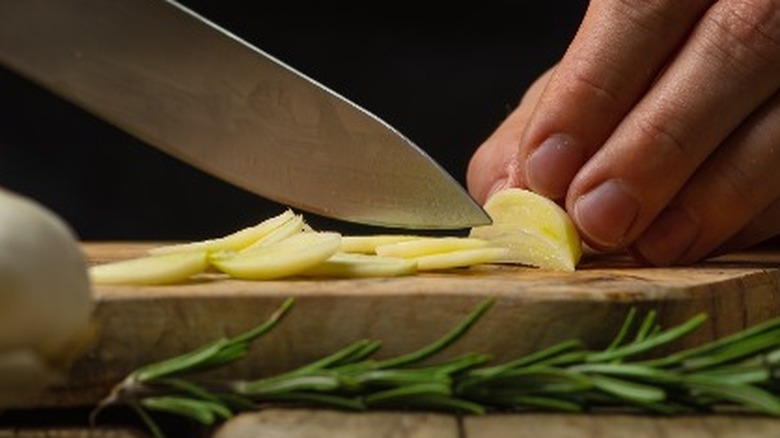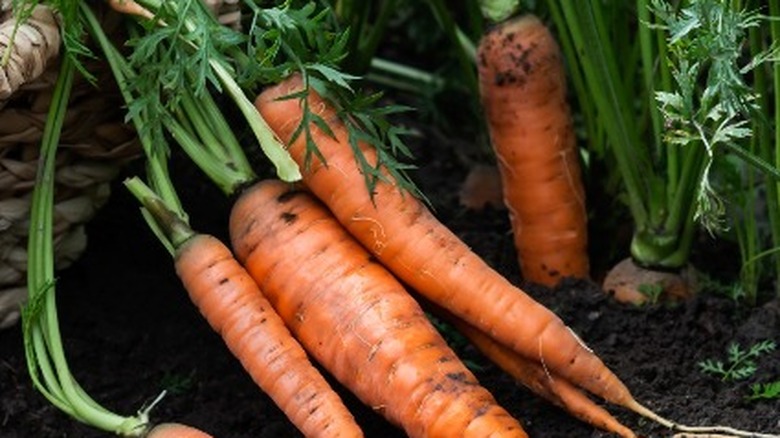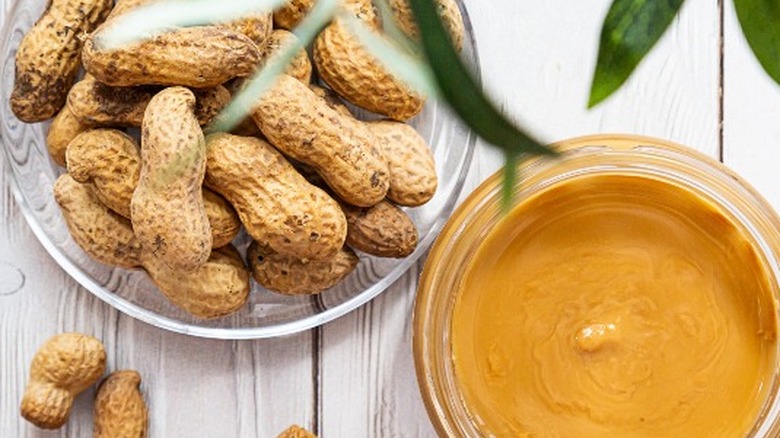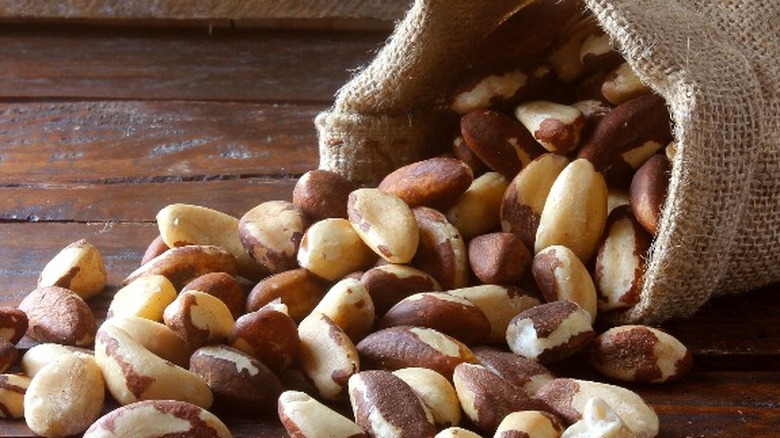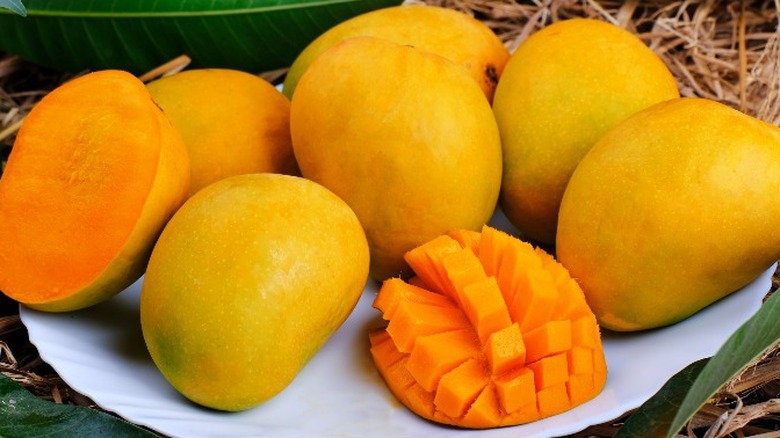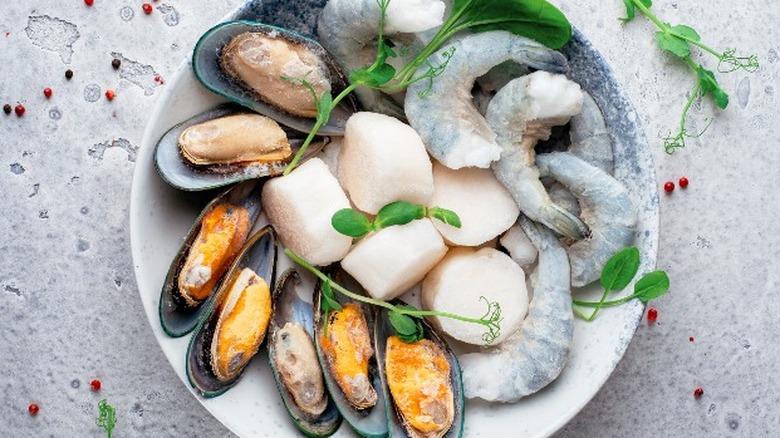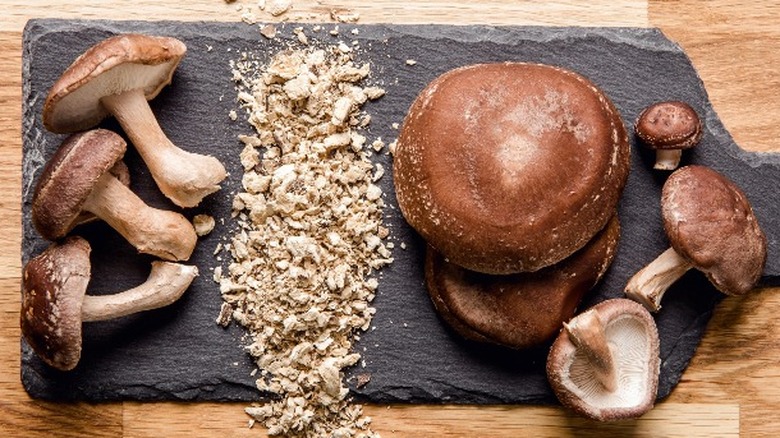14 Foods You Should Eat To Boost Your Keratin Levels
Keratin is an essential protein that our bodies produce naturally to form nails, hair, and the outer layer of skin (via the Cleveland Clinic). It is also found in other parts of the body, including the lining of internal organs and glands. It is an incredibly resilient protein unaffected by the chemicals found in the body.
Healthy levels of keratin can improve the strength and appearance of the skin, hair, and nails (via the Cleveland Clinic). With such beneficial effects, keratin has recently become a new trend and an increasingly popular ingredient in beauty products (per ReportLinker). In fact, the published analysis shares projections that the global keratin market will grow to $2.4 billion by the year 2030.
However, other than topical keratin treatments and cosmetics, you can help boost your keratin levels by eating different types of food that support your body's ability to produce and synthesize this crucial protein. Here are 14 foods to consider adding to your diet if you're hoping to maximize the health benefits of increased keratin production.
Sweet potatoes
Sweet potatoes are a versatile, nutrient-packed vegetable that many people enjoy for their high levels of fiber, potassium, and vitamins. Among their many benefits, sweet potatoes are an excellent source of beta-carotene, a provitamin compound often found in vibrantly-colored orange, yellow, and red vegetables (per WebMD). Once ingested, the body converts beta-carotene into vitamin A, a powerful antioxidant that may prevent damage to cells (via Medical News Today).
According to an article published in Dermato Endocrinology, vitamin A may play a significant role in the growth, differentiation, and regulation of keratin. Some studies included in the article even highlight the ways in which retinoids, a derivative of vitamin A, can be used to treat skin disorders that result from keratin mutations.
Just one medium-sized skin-on baked sweet potato packs a punch with 1,403 micrograms of vitamin A, or 156% of the recommended daily value (via the Office of Dietary Supplements). You can try adding sweet potatoes to your diet in place of potatoes or other starchy foods to increase your intake of vitamin A, which may help boost your keratin levels.
Eggs
As a rich source of biotin, protein, and other nutrients, eggs can be a healthy addition to any diet. A whole cooked egg contains about 10 micrograms of biotin, or 33% of the recommended daily value (per ODS). According to a published review of studies in Skin Appendage Disorders, biotin can have beneficial effects on keratin production and protein synthesis.
The Skin Appendage Disorders review shares reports on the results of biotin treatment on hair and nails, which are primarily composed of keratin. All published cases in which patients received biotin showed evidence of clinical improvements in poor nail or hair growth.
In addition to biotin, a single egg also provides 6.25 grams of protein (via the U.S. Department of Agriculture). According to a research article (via by the Department of AgricultureEngineer, Iran), protein is necessary for the body to produce keratin. With high biotin and protein content, eggs can be an excellent food to include in your keratin-boosting meal plan.
Salmon
Salmon is a protein-packed powerhouse fish that has several health benefits (per Healthline). It contains biotin, vitamin D, omega-3 fatty acids, and protein, which are key nutrients that may support keratin production.
With research showing the importance of eating high-protein foods to help the body produce keratin, salmon is an ideal choice. A five-ounce portion of cooked salmon (142 grams) has 27 grams of protein — an impressive 54% of your daily value (via NutritionalValue.org). In addition, a recent study published in the International Journal of Trichology showed that test subjects who took a marine-based protein supplement saw significantly reduced hair shedding and increased mean hair diameter. According to the Office of Dietary Supplements (ODS), a three-ounce serving of canned salmon provides 5 micrograms of biotin, or 17% of the recommended daily value. Biotin can improve the health of hair and nails by stimulating keratin production (via WebMD).
Salmon is also a great source of vitamin D, with 14.2 micrograms in three ounces of cooked sockeye salmon (via ODS). This represents 71% of the recommended daily value of vitamin D, which a review published in Cureus shows can affect hair loss if there is a deficiency. Lastly, salmon is full of omega-3 fatty acids. According to a review in the Marine Drugs journal, polyunsaturated fatty acids (PUFAs), such as omega-3s, can help to prevent keratinocyte damage induced by UV light. Keratinocytes are what produce keratin in the skin (via the National Library of Medicine).
Onions
Onions are another food to add to your diet to help boost keratin levels. Onions are naturally high in the antioxidant N-acetylcysteine, which the body converts to L-cysteine, an essential component of the keratin protein. A recent study published in the Journal of Cellular Biochemistry has shown that cysteine supplementation can assist with keratin regulation. The study also shared that cysteine counters adverse iron deficiency effects on keratin at the cellular level.
Another key nutrient found in onions is folate, a B vitamin that helps with cell metabolism. A study included in a Dermatology and Therapy review on the role of vitamins and minerals in hair loss showed that folate deficiency can be tied to the loss of hair. In addition, onions are a good source of the mineral sulfur, which is also found in keratin (per Medical News Today).
Fortunately, onions are readily available allium vegetables that are relatively inexpensive. You can try incorporating more onions into your favorite dishes to add flavor and possibly ramp up your keratin production.
Kale
Kale, a deep-green leafy vegetable, is an excellent source of vitamins A and C (via the USDA). Just one cup of kale has 206% of the recommended daily value of vitamin A and 134% of vitamin C. These vitamins may play an important role in supporting keratin production and differentiation.
A review in Frontiers in Physiology shared how vitamin C can help with keratinocyte differentiation, or the development of the cell into a more specialized type of keratin-producing keratinocyte. This process can help repair the skin and heal wounds in response to the environment, according to research found in the International Journal of Molecular Sciences. Meanwhile, Dermato Endocrinology published an article highlighting the ways in which vitamin A can impact the regulation of keratin genes and expression. The research also shows that retinoids, which are vitamin A derivatives, can be used to treat skin disorders that are the result of keratin mutations.
However, it's essential to speak with your healthcare provider to see if additional vitamin A intake is appropriate for you. Having too much vitamin A in the body can actually have adverse effects, including hair loss (per the Cleveland Clinic). If you exceed the recommended dietary allowance (RDA) of 900 micrograms for adult men and 700 micrograms for adult women, it may be harmful to your health (via the Harvard T.H. Chan School of Public Health).
Sunflower seeds
Packed with protein, biotin, selenium, and other nutrients, sunflower seeds are a great snack if you're hoping to improve your body's keratin levels. While biotin can be found in beef, eggs, salmon, and pork, sunflower seeds are a vegetarian option that provides 2.6 micrograms of biotin in a ¼ cup serving (via ODS). Studies published in the Skin Appendage Disorders journal show that biotin may help strengthen hair and nails by supporting the body's production of keratin.
Sunflower seeds also contain 9.6 grams of protein in a one-cup serving, which is 19% of the recommended daily value (via NutritionalValue.org). Because hair and nails are built of protein, eating protein-rich foods can help provide the amino acids that make up keratin, according to research published by the Department of Agriculture Engineer, Iran.
Another nutrient found in sunflower seeds is selenium, a mineral antioxidant that has several health benefits (per Medical News Today). One cup of sunflower seeds provides 44% of the daily value of selenium, or 24.38 micrograms (per NutritionalValue.org). Selenium makes up selenoproteins, which a research article in PLOS ONE journal shows are necessary for the proper function of keratinocytes and keratin production. However, be sure to avoid adverse effects by staying under the tolerable upper intake level of 400 micrograms for adults (per ODS).
Beef liver
While beef liver is not something most people eat every day, it is an excellent source of biotin, with 103% of the recommended daily value in a cooked three-ounce portion. Biotin can help with keratin production by stimulating hair follicle growth (per WebMD). Also, a review published in Skin Appendage Disorders showed there were clinical improvements to hair and nail growth in subjects receiving biotin.
Beef liver is also rich in protein, which research shows is essential for keratin production. There are 20.35 grams of protein per 100 grams of beef liver (via USDA), giving it the most protein content compared to other organ meats (per Medical News Today).
Vitamin A is another nutrient found in beef liver in abundance. Although studies show that vitamin A can help support keratin production and regulation, three ounces of cooked beef liver contains an incredible 731% of the recommended daily value (per ODS). Talk to a healthcare professional to see if beef liver and vitamin A are good options for you.
If you're unsure how to add beef liver to your diet, you can try swapping out other sources of protein in your go-to dishes for this biotin-dense organ meat. However, there will be some differences in taste and texture. It's worth trying different beef liver recipes until you've found one you can easily incorporate into your meal rotation.
Garlic
Similar to the benefits of eating onions, adding garlic to your food can help with keratin levels due to its high N-acetylcysteine content (via NRLS Conference Proceedings). The body converts N-acetylcysteine into L-cysteine, which is an essential amino acid found in keratin proteins. Placebo study results published in Future Medicine found that women experiencing thinning hair saw significant improvements after taking supplements containing L-cysteine.
A study published in Nutrients also shows garlic extract may have an impact on keratinocytes, the cells responsible for producing keratin. The study results show that garlic extract can protect keratinocytes from UV-induced cell damage and reduce free radicals. The garlic extract was prepared by drying fresh garlic and grinding it into a powder.
Other nutrients found in garlic include vitamin C and selenium. According to research published in Frontiers in Physiology, vitamin C can help with keratinocyte differentiation and cellular development. Other studies found that selenium makes up selenoproteins, which support keratinocyte function and the production of keratin (via PLOS One).
Carrots
Carrots have long been recognized for their health-boosting properties, including improved eye health, a strengthened immune system, and balanced blood pressure (via WebMD). However, the nutrients found in carrots can also help the body with keratin production.
Like many other yellow and orange vegetables, carrots contain a rich amount of beta-carotene, which the body converts into vitamin A (per Healthline). One cup of chopped raw carrots provides an impressive 119% of the recommended daily value of vitamin A (per NutritionValue.org).
Dermato Endocrinology published an article sharing how vitamin A and retinoids can help with keratin regulation, development, and differentiation. It also showed that some skin disorders related to keratin mutations could be treated using retinoids, which are a derivative of vitamin A.
In addition to the high levels of vitamin A found in carrots, this orange root vegetable is a good source of biotin and other antioxidants. As shown in a review published in Skin Appendage Disorders, biotin can help improve the strength of hair and nails, both of which are made of keratin proteins. Biotin may also stimulate keratin production and growth of hair follicles (per WebMD).
Peanuts
Peanuts are legumes that are rich in plant-based protein, which research shows can help with keratin production (via Department of Agriculture Engineer, Iran). If you're trying to avoid meat, poultry, and seafood but want to increase your protein intake, peanuts may be a good choice. Data published in the Journal of Food Science and Technology shows that peanuts provide 46% of the recommended daily value of protein in a 100-gram serving. The data also notes that peanuts have more protein content than any other nut.
According to published values of biotin content in the National Library of Medicine, roasted peanuts also provide a good source of biotin. One ounce of roasted peanuts contains about 17% of the recommended daily value of this important B vitamin. Research has shown that biotin can produce clinical improvements in hair and nail growth and promote keratin production (via WebMD).
Snacking on roasted peanuts is a great way to add them to your diet. However, you can also try cooking with ground peanuts or adding them as a topping to salads or yogurt.
Brazil nuts
Brazil nuts are an excellent source of selenium, which research has shown to be vital for proper functioning keratinocytes, the skin cells responsible for producing keratin (via PLOS One). Per the research article, selenium is essential to create the selenoproteins necessary for keratinocyte growth and development.
However, consuming too many brazil nuts can have negative effects on your health, so it's important to consult with your doctor before adding unmeasured amounts to your diet. According to the Office of Dietary Supplements, one ounce (six to eight brazil nuts) can provide 544 micrograms of selenium, or 989% of the recommended daily value. For reference, the upper intake level for selenium in adults is 400 micrograms.
Brazil nuts also contain about 10.5% of the daily intake of zinc, an essential trace element (via Healthline). Some studies published in Dermatology and Therapy have shown that zinc supplementation in the diet may help with hair regrowth in those with alopecia — unsurprising, since hair is mainly comprised of keratin protein (per WebMD).
Mangoes
Mangoes are more than just a sweet and juicy treat. They are also loaded with healthy nutrients that can help you boost your body's keratin levels. Most notably, one cup of sliced mangoes contains about 60 milligrams of vitamin C and 89 micrograms of vitamin A (via the USDA).
Research published in Dermato Endocrinology discusses how vitamin A retinoids derived from vitamin A can impact the production and regulation of keratin proteins. The data shows how retinoids can treat skin disorders by supporting the growth and differentiation of keratin-producing cells. As a natural source of vitamin A with 10% of your daily value, mangoes are a worthwhile addition to your diet if you're looking to improve keratin levels.
Mangoes are also an excellent source of vitamin C, offering 67% of your recommended daily value (via NutritionValue.org). Data published in Frontiers in Physiology shows a connection between vitamin C and keratinocyte differentiation, which is the process of the keratin-producing cells developing into a more specialized type of keratinocyte.
Shellfish
Shellfish are animals that live in water and have a hard exterior or shell, such as shrimp, crab, lobster, clams, oysters, and mussels. They are often high in protein and contain other nutrients that may help with keratin levels, including zinc and omega-3 fatty acids (per Healthline).
According to a review in the Journal of Immunology Research, zinc may play an essential role in keratinocyte differentiation and skin cell repair. Keratinocytes are the skin cells responsible for the production of keratin, among other crucial functions (per Merriam-Webster).
Shellfish are also a good source of omega-3 fatty acids. A review in the Marine Drugs journal shows that omega-3s and other polyunsaturated fatty acids (PUFAs) may aid in preventing UV damage in keratinocytes, which are the epidermal cells that produce keratin.
However, shellfish is one of the most prominent allergies, with about 2% of the American population claiming to have allergic reactions to shellfish (per Food Allergy Research and Education). If you've never had shellfish before, there are ways to test for sensitivities before you add them to your diet.
Mushrooms
Mushrooms can be a tasty and versatile addition to your diet, and they also provide key nutrients and vitamins that may help with keratin production. For example, mushrooms are an excellent source of biotin, which research has shown to support keratin production (via Skin Appendage Disorders). Shiitake mushrooms have the most biotin content, with 36.6 micrograms (per WholeFoodCatalog). Some published cases in which patients received biotin resulted in significant improvements to poor nail and hair growth.
Mushrooms are also a natural source of vitamin D, an essential vitamin that may help to regulate the development of keratinocytes. According to the Office of Dietary Supplements, a half-cup serving of raw mushrooms exposed to UV light contains 46% of the recommended daily value of vitamin D. Research published by Oregon State University shared how keratinocytes convert vitamin D to its active form in the body, which then locally controls keratinocyte differentiation and proliferation. Also, data shows vitamin D supplementation has been linked to hair regrowth.
Try adding mushrooms to soups, salads, pasta dishes, and as toppings to protein. They can add subtle flavor and texture to your favorite dishes while boosting your intake of keratin-supporting nutrients.

